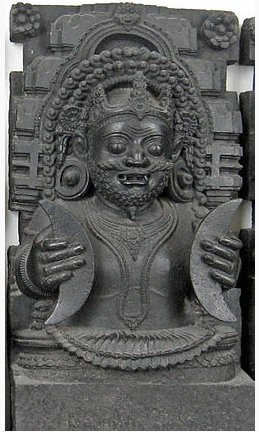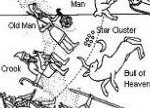Next page of comments regarding line Ga1 begins with my statement that the new generation follows the old one and is the same. But technically this is wrong - because the old generation disappears only after the new life has begun (cfr for instance Ulu and Moku Ola). The true spark of life, will be transferred only when the 'dry old bone' is going away, relaying it to the young one. Life necessitates death and after the disappearance of the old generation follows the new which is basically the same: ... And then the bone spoke; it was there in the fork of the tree: Why do you want a mere bone, a round thing in the branches of a tree? said the head of One Hunaphu when it spoke to the maiden. You don't want it, she was told. I do want it, said the maiden. Very well. Stretch out your right hand here, so I can see it, said the bone. Yes, said the maiden. She stretched out her right hand, up there in front of the bone. And then the bone spit out its saliva, which landed squarely in the hand of the maiden. And then she looked in her hand, she inspected it right away, but the bone's saliva wasn't in her hand. It is just a sign I have given you, my saliva, my spittle. This, my head, has nothing on it - just bone, nothing of meat. It's just the same with the head of a great lord: it's just the flesh that makes his face look good. And when he dies, people get frightened by his bones. After that, his son is like his saliva, his spittle, in his being, whether it be the son of a lord or the son of a craftsman, an orator. The father does not disappear, but goes on being fulfilled. Neither dimmed nor destroyed is the face of a lord, a warrior, craftsman, an orator. Rather, he will leave his daughters and sons ...
... In Hindu tradition, Rahu is a cut-off head of an asura, that swallows the sun or the moon causing eclipses. He is depicted in art as a serpent with no body riding a chariot drawn by eight [8] black horses ... According to legend, during the Samudra manthan, the asura Rahu drank some of the divine nectar. Sun and moon realized it and they alerted Mohini (the female avatar of Vishnu). Before the nectar could pass his throat, Mohini cut off his head. The head, however, remained immortal. It is believed that this immortal head occasionally swallows the sun or the moon, causing eclipses. Then, the sun or moon passes through the opening at the neck, ending the eclipse ...
I feel rather certain the waxing and waning crescents correspond to those in the hands of Rahu. Elnath (the Butting One) in Ca1-16 could be illustrated as a being not yet fully developed inside his egg. The Bull of Heaven has only a single significant horn, his right horn, like the egg tooth of a chicken ready to break out:
It is adequate to have a waxing crescent preceding in the glyph text. It has 'feathers' in front which means it cannot represent a dry old bone. The egg comes before the old one goes away. The old one could be the lost head of Orion, hidden behind the Heka tripod. At birth the first part to emerge is normally the hair on the scalp. To distinguish the 7 signs in front in Ga1-15 from the maro sign (e.g. in Ga1-17) we should not say there are 'feathers' in front in Ga1-15, we should rather say there is 'hair' in front. A feather is bilaterally symmetrical:
These reflections are not in my comments. Neither have I pointed out the possible correspondence between the pair of mirror crescents on one hand and the pair of mirror crooks on the shepherd's staffs on the other: The staff of the Old Man is broken (hatiga te koe). We can therefore guess this place corresponds to the kuhane station Hatinga Te Koe. ... The dream soul went on. She was careless (?) and broke the kohe plant with her feet. She named the place 'Hatinga Te Koe A Hau Maka O Hiva'. The dream soul went on and came to Roto Ire Are. She gave the name 'Roto Ire Are A Hau Maka O Hiva'. The dream soul went on and came to Tama. She named the place 'Tama', an evil fish (he ika kino) with a very long nose (he ihu roroa). Her next station was Roto Ire Are which could refer to the 'hair' emerging. In the Milky Way river such hairs would be like sea-weed, something which would be hard to explain otherwise:
Tama (the child who is being born) had a very long nose. Normally children are born face down and the very long nose of the 'evil fish' could possibly explain the prolonged part ('nose') at bottom in Ga1-15. Instead the following is the last part of my commentary page:
The central glyph in the 'eclipse sequence' (Ga1-17) has a maro (feather) string hanging down, a sign which should mean a border mark ('finish line'). In 1582 A.D. the nakshatra point at the Full Moon was 260 (= 1842 - 1582) days after ºMarch 21 (= ºDecember 6). ... There is an account of the star from the Khitan Liao Dynasty, which ruled in the area around Manchuria from 907–1125. The book in question, the Qidan Guozhi, was compiled by Ye Longli in 1247. It includes various astronomical notes, some of which are clearly copied from the Song Shi. This entry referring to the star of 1054 seems unique: Chongxi era of the reign of [King Xingzong], twenty-third year eighth [8] lunar moon, the ruler of the realm is dead. It happened before a solar eclipse at noon, and a guest star [the nova SN1054 - which was observed in the year 1054 A.D. and then evolved into the Crab Nebula] appeared. The highest office at the Office of History, Liu Yishou had said 'These are omens of the death of the King.' This prediction has been realized ... Early in my efforts to try to understand what the glyphs depicted I imagined Ga1-18 looked like a crab. Now, after having discovered the place of the nova SN1054 (nowadays of course quite invisible) which evolved to the Crab Nebula (visibility only 8.4), I guess the creator of the G text indeed alluded to the resemblance between a death skull and a crab - both with 'exosceletons' and nothing growing on them. The empty eye-socket in front ought to mean 'not visible'.
| ||||||||||||||||||||||||||||||||||||||||||||||||||||||||||||||||||||||||






